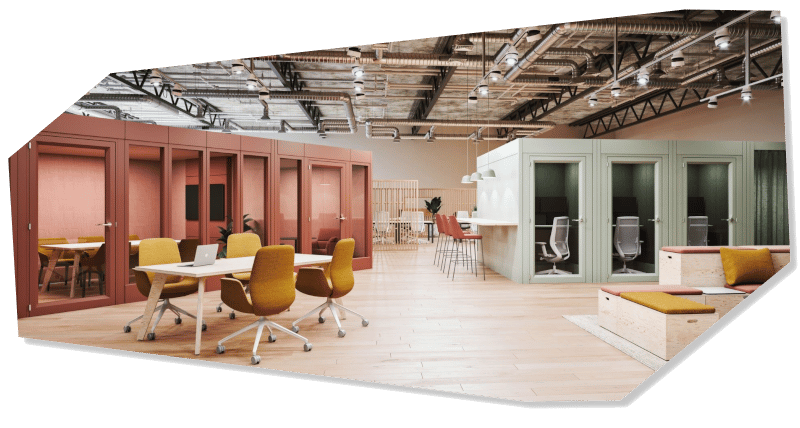When considering workplace change, deciding whether to stay put or move to new premises is one of the most important decisions you’ll make. Can you live with the space you’ve got by simply making changes to the layout and facilities within the existing space? Or do you need to move to a new space altogether?
Whether upsizing or downsizing, or simply rethinking the way your workplace is structured, you will need to consider the following factors.
The first steps of Stay or Go decision making
Before you dive into the process of analysing your workspace needs and priorities, there are a few basics that need to be established in order to provide a framework for your decision making. Here, we look at some of the key points to consider.
Establish your timeline
The first thing to do when deciding whether to stay or go is to map out your timeline. When is the date of your next lease break or expiry? At what point do you have to serve notice to your landlord? How urgent are your workspace change needs – can it wait until your next lease event or not?
The importance of location
You will also need to understand whether location – the one you are in now, or a proposed move – is central to your reasons for change. It may be that this factor alone dictates whether you stay and refurbish or move to new premises – although in reality the decision is rarely that simple.
Know your budget
Regardless of the medium and long-term cost implications of a move or refurbishment, you will need to establish a ballpark figure for how much you can commit to the process in the short term. Whether you choose to move or to stay and remodel, there will be a significant financial outlay, and understanding where the business stands on this will help to focus your efforts and rule out unviable options.
The case for staying
There are various reasons why staying put might appear the most attractive option – but you should beware of making assumptions and falling foul of common misconceptions. In the next section we’ll look at the role workspace consultancy plays in making an informed decision, but it’s worth first listing some of the reasons why businesses choose to refurbish or remodel rather than moving out.
Familiarity
You’re already familiar with the space you occupy and are likely to be in a good position to determine how best to remodel it to best meet the changing needs of your organisation. However, you shouldn’t let this blind you to the potential that a new space might offer.
Logistics
Staying in your current location is likely to be logistically easier than moving your whole company – people, technology, equipment, files, etc. – to a new location. However, refurbishing in occupation can present its own challenges, as you will need identify a swing space for your people to occupy while work is carried out, and it may also need to be done in phases.
Flexible timeline
If remodelling rather than moving, you don’t need to worry about lease events, notice periods or similar contractual constraints. This can take the pressure off the process, allowing you to make changes when best suits the business, rather than being driven by external factors.
Financial considerations
Moving requires dilapidation costs, legal costs, logistics costs, and acquisition agents’ costs among other things. However, these are short-term costs and may be more than offset by financial gains made over the long term, whether moving to a cheaper location or choosing to occupy less space, among other things. The financial case needs to be looked at holistically in order to determine your genuine best interests.
Challenge your assumptions
A decision as important as whether to stay or move premises needs to be based on a holistic, evidence-based view, rather than on intuition or what you think you know. It’s worth engaging with a commercial property agent to do some market research on alternative options, market rates and incentives offered by landlords.
Most importantly, you will be best served by engaging with workspace consultants, who can help you analyse your business needs and drivers for change, use of space and technology, and provide a blueprint against which to benchmark your options.
The case for moving
If you’ve definitively outgrown your space, or feel the location or amenities are no longer fit for purpose, then the appeal of moving presents an attractive blank canvas and the chance to start a ‘new chapter’ for your organisation. As with choosing to stay put, you need to be aware of getting swept up in the vision without interrogating its practicality. Here are some of the considerations businesses contend with when deciding to move.
A better deal
Moving presents an opportunity to negotiate a new lease, which may mean you can secure better rates and terms than your current premises. This isn’t guaranteed however, and you need to be aware of changing conditions in the property market, levels of demand and occupancy, and also keep in mind that not all locations are of equal value. You may also have an opportunity to renegotiate with your current landlord if a lease break is immanent.
Reducing floorplate size
Many businesses have undergone dramatic changes in the way they work in recent years, with the move to hybrid and location-independent working providing an opportunity for businesses to work with a lower desk-to-staff ratio, saving considerable property costs. However, you may be able to take this route in your existing premises, either by handing back some of the space to the landlord, or by choosing to sublet, or set up a coworking space to generate revenue.
A world of options
Moving represents a chance to leave behind all the bug bears and imperfections of your existing space, with a range of options on the table for your new premises. It can be easy to think the grass is greener, however you need to make sure you don’t get carried away with the promise of the new, and take time to identify potential issues and imperfections with the new spaces on offer. Nowhere is perfect, and you want to make sure that your move genuinely represents a step up before you commit.
The importance of objectivity
The decision to move offices isn’t one you have to make alone. You’ll need to work with property agents and your legal representatives to discuss your options. Most importantly, it will reap dividends if you engage with workspace consultants early in the process to help understand your real workspace needs, rather than relying on preconceptions.
Taking the time to analyse and build your ideal workspace blueprint will put you a firm footing for any decision you make. In our next blog, we’ll look at how this blueprint takes shape.
How Office Workspace can help
We can help you to take the first steps on your journey to a more productive, effective and engaging workplace. It’s as simple as having an informal chat with one of our workspace team, to find out a bit more about your business and your drivers for change.
To find out more about how we can help you to innovate the way you work, get in touch by emailing hello@officeworkspace.com or calling +44 (0)20 8039 0000. You can also fill out our online contact form, and we’ll get back to you as soon as possible.

